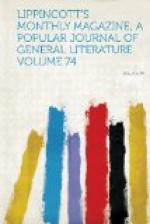There has been abundance of doubt, but no difficulty, in disposing of the great number of buildings which have thus come into the possession of the nation. Many of the smaller convents have been sold in the same manner as the other property of the ousted communities. But this has not been done—and indeed could hardly have been done—in the case of the larger buildings; and there has been a competition very much in the nature of a scramble for the appropriation of them by the heads of the several governmental departments. That of Public Instruction, now worthily represented by Signor Bonghi, has succeeded in laying hands on perhaps the grandest prize of all, the great Jesuit establishment of the Collegio Romano; and, looking to the uses to which it is being put by Signor Bonghi, it may, I think, be said that it could not have been better bestowed. Under his auspices it is intended to assume, and is indeed rapidly assuming, the functions of the still vaster pile of building in Great Russell street, London, known to all the world as the British Museum, as will be seen from the following statement of the purposes it is intended to serve and of the various matters to be housed in it.
On the ground-floor there is already established a “Museo Scolastico-Pedagogico”—a museum of all the means and appurtenances that are used, or have been used, in different countries for the ends and purposes of instruction. This is the idea and the creation of Signor Bonghi; and it will, I think, be admitted that it is a very happy one and likely to be fruitful in good results. A visit to it is more interesting than might perhaps at first sight be imagined. I may mention that on asking the very competent and enlightened director of the establishment what people he considered to have done most and as foremost in the work of educating the masses, he said that the Germans had done most theoretically and in the way of thinking on the philosophy of the matter, but that the Americans had done most practically in the way of improving the material means for popular education.
On the first and second floors the great national library, the “Biblioteca Vittorio Emmanuele,” is—or, it would perhaps be more accurate to say, will be—placed and made accessible to the public. At Florence there exists the celebrated Magliabecchian Library, which when Florence became the capital of Italy was called the National Library—somewhat ungratefully, it will probably be thought, to the learned and indefatigable collector who gave his life and his means to the formation of it, and then bequeathed it to his native city. And I am inclined to believe that this library is still, for all the general working purposes of a nineteenth-century student, the best in Italy. In Rome, when the Eternal City in its turn became the capital of a New Italy, there existed nothing that deserved to be called a national library, and the present minister of Public Instruction set about doing what was possible to supply the want.




